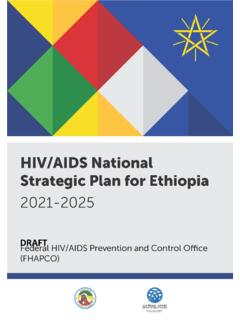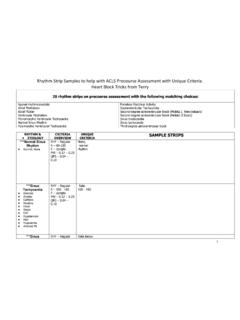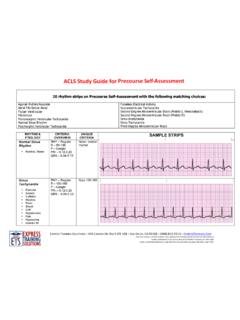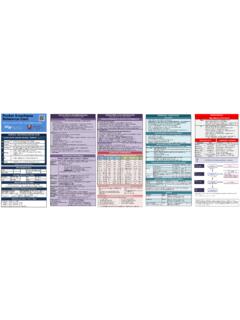Transcription of FEDERAL MINISTRY OF HEALTH, ETHIOPIA
1 FEDERAL MINISTRY OF HEALTH, ETHIOPIA NATIONAL INTEGRATED EMERGENCY MEDICINE TRAINING PARTICIPANT S MANUAL October, 2015 1 APPROVAL STATEMENT OF THE MINISTRY The FEDERAL MINISTRY of health of ETHIOPIA has been working towards standardization and institutionalization of in-service (IST) trainings at national level. As part of this initiative the MINISTRY developed a national in-service training directive and implementation guide for the health sector. The directive requires all in-service training materials fulfill the standards set in the implementation Guide to ensure the quality of in-service training materials. Accordingly, the MINISTRY reviews and approves existing training materials based on the IST standardization checklist annexed on the IST implementation guide. As part of the national IST quality control process, this Integrated Emergency Medicine IST package has been reviewed based on the standardization checklist and approved by the MINISTRY in October 2015.
2 Dr Getachew Tollera Human Resource Development & Administration Directorate Director FEDERAL MINISTRY of Health, ETHIOPIA 2 Foreword The ETHIOPIA s FEDERAL MINISTRY of Health (FMOH) has been leading a sector wide reform effort aimed at significantly improving the quality and accessibility of health services at all levels of the country s decentralized health system. As part of this reform, health facilities throughout the country have been streamlining their operational processes and building their capacities with a view to making their services more effective and efficient. Recognizing the importance of strengthening Emergency Services at all level: pre facility and facility level is one of the areas priority given. Obtaining of huge number of ambulances and ongoing initiatives towards training of Emergency Medical Technicians (EMT) to promote pre facility health care and to improve accessibility to health facilities for mothers and acutely ill or injured patients are some of the activities on progress.
3 At health facility level reorganizing services into emergency and none emergency; staffing by case teams with a well-rounded skill mix, equipping emergency units in hospitals with triage and resuscitation equipment s, supporting hospitals with on job emergency medicine trainings are areas getting focus on the improvement process of intra facility emergency services. This National Integrated Emergency Medicine Training guideline contains; trainees reference, facilitator manual with its case scenario and pretest. It focuses on common emergency health problems of all age and sex, and aims on the primary emergency care approach, resuscitation and stabilization in emergency department or emergency rooms until patients will streamed to their respective departments, and both mid level and high-level health professionals working in health facilities can use this manual as a reference. While primarily intended as a reference for hospital personnel, it is hoped that health professionals across all level of national health facilities will also find this guideline useful.
4 At this venture, I would like to take this opportunity to express my profound appreciation to all partners that have participated in the development of this important reference and training document. Special thanks go to our colleagues at the Addis Ababa University Medical School Emergency Department staff for mobilizing appropriate resource personnel s for the development of this reference guideline. 3 Dr. Abraham Endeshaw Director, Medical Services Directorate FEDERAL MINISTRY of Health Acknowledgement The FEDERAL Democratic Republic of ETHIOPIA MINISTRY of Health would like to acknowledge the Emergency Medicine Department of Addis Ababa University School of medicine; for its immense technical and academic support . The resource the department has and the enthusiasm of the staff is an asset for establishing emergency medicine in ETHIOPIA . The FMOH would like also to acknowledge the following individuals for their participation on the development of this reference guideline.
5 1. Dr. Aklilu Professor/Addis Ababa University, school of Medicine 2. Dr. Assefu Professor/ Addis Ababa University, school of Medicine 3. Dr. Sisay Teklu ..Ass. Professor/ Addis Ababa University, school of Medicine 4. Dr. Nebeyu Seyum ..Ass. Professor / Addis Ababa University, school of Medicine 5. Dr. Muluwork Denberu ..Ass. Professor/ Addis Ababa University, school of Medicine 6. Dr. Tigist Professor/ Addis Ababa University, school of Medicine 7. Dr. Biruk Girma ..Lecturer /Addis Ababa University, school of Medicine 8. Dr. Abduraheman Addis Ababa University, school of Medicine 9. Dr. Sophia Kebede ..Lecturer/ Addis Ababa University, school of Medicine 10. Dr. Alemitu Tamiru ..Anesthesiologist/Zewditu Metasebia Hospital 11. Dr. Zelealem Paul millennium Medical College 12. Dr. Amanueal University Hospital 13. Dr. Tewodros Gondar University Hospital 14. Dr. Mekonnen Gondar University Hospital 15. Dr. Helena EMSs coordinator/FMOH/MSD 4 16.
6 Medical service directorate, Emergency case team/FMOH 5 Acronyms ABC=Airway Breathing Circulation TTC= Tetracycline RBS=Random blood sugar IM=Intra muscular IV=Intra venous Po= per Os JHR= Jarisch Herxheimer Reaction GCS= Glasgow coma scale Dx=Diagnosis DDX=Differential diagnosis BP=Blood pressure PR=Pulse rate RR=Respiratory rate Hx=History P/E=Physical examination Bpm=Beats per minute Mx=Management Sxs=Symptom Sns=Sign Rx=Treatment URT=Upper respiratory tract ED=Emergency department EMT=Emergency medical technician EMS=Emergency medical service ECG-Electrocardiogram CXR=Chest x-ray CPR=Cardio pulmonary resuscitation PTE=Pulmonary thromboembolism OFTs=organ function test C/I=contraindication 6 UFH= Unfractionated Heparin SC=Subcutaneous GFR=Glomerular filtration rate ACEIs= Angiotensin converting enzyme inhibitors LMWH = Low Molecular weight Heparin UTI =Urinary tract infection U/A=Urine analysis CSF=Cerebrospinal fluid LFTs=Liver
7 Function tests AFB= Acid fast bacilli WBCs=White blood cell Hct=Hematocrit Hgb=Hemoglobulin MAP=Mean arterial pressure SIRS = Systemic Inflammatory Response syndrome JVP= Jugular vein pressure BUN= Blood urea nitrogen PT = Prothrombin time INR= International normalized ratio MDI- metered dose inhaler SABA= short acting beta agonist PEF= peak expiratory flow ICP= intra cranial pressure ETT= endotracheal tube NSAIDs = non steroidal anti inflammatory drugs DKA= diabetic Ketoacidosis, acls = advanced cardiac life support . BLS=basic life support , MI = Myocardial infarcion, CVA=cerbrovascular accident, HHS =Hyperglycemic hyperosmolar state 7 Table of Contents Foreword .. 2 Acknowledgement .. 3 Acronyms .. Error! Bookmark not defined. Introduction .. 10 Course Syllabus .. 11 Course description .. 11 Course Goal .. 11 Course objectives .. 11 Course evaluation .. 11 Courseduration .. 11 Training/Learning Methods .. 12 Instructional materials, supplies and equipment needed in the training.
8 12 Target audience .. 12 Facilitator/Trainer selection criteria .. 12 Facilitator s responsibilities .. 13 Trainees assessment, qualification and criteria for certification .. 13 Core competencies .. 13 Schedule of National Integrated Emergency Medicine Training .. 14 Chapter I: Emergency Medical Service 17 Pre-hospital EMS: .. 17 Hospital EMSS: .. 19 Chapter II: Airway assessment and Management .. 23 Manual methods .. 25 Head tilt/Chin lift .. 25 Jaw thrust .. 25 Chapter III: Assessment of Breathing and management .. 33 Chapter IV: Basic life support .. 38 Aims: The 4 main aims of primary assessment 4 Ps are: .. 38 Preserving life : In order to preserve life look for: .. 39 Chapter V: advanced resuscitation of cardiac arrest .. 45 Chapter VI: Triage .. 62 8 Chapter VII: Approach to the Management of Common Medical Emergencies .. 68 Respiratory emergencies .. 68 Pneumonia .. 74 Common abnormalities of circulation .. 77 Learning Objectives.
9 77 Heart Failure and Pulmonary Edema .. 79 Heart Failure .. 79 Work up .. 82 Management .. 83 Pulmonary edema .. 86 Hypertensive Crises .. 88 MX of suspected Acute Coronary Syndrome (ACS) in the ED .. 91 Emergency approach to a Bleeding patient and Shock .. 95 Upper GI(UGI) BLEEDING .. 95 Epistaxis .. 98 Shock .. 99 Common Neurologic Emergencies .. 104 108 Status Epilepticus .. 111 Approach to an acute febrile illness (AFI) in the emergency department .. 113 Emergency management of Common Endocrine Emergencies .. 118 Diabetic Ketoacidosis .. 118 Toxicology .. 125 Organophosphate & Carbamates poisoning .. 127 2, 4 D poisoning: .. 128 Corrosives .. 129 Carbon monoxide poisoning .. 129 Barbiturates .. 130 Snake bites .. 130 Chapter VIII : Assessment and management of trauma .. 132 Learning objectives .. 132 BASIC PRINCIPLES OF EMERGENCY WOUND EVALUATION .. 143 9 Management of Burns .. 151 Management of orthopaedic emergencies.
10 157 Pain Management in the Emergency Department .. 172 Chapter x: Obstetric 178 ChapterXI: PEDIATRICS EMERGENCY MEDICINE (PEM) .. 197 Routes of Exposure .. 216 Poisoning is divided into accidental poisoning and non accidental or self poisoning.. 217 The effects of poison .. 217 Annex .. 221 Dose .. 232 10 Introduction Emergency Patient care is a comprehensive and continuous care provided for those who are sick, injured or presented with obstetric emergencies, involving trained personnel in order to decrease morbidity and mortality using available and accessible technology and manpower According to 2005 (EFY) data, trauma was the 8th cause of morbidity (1,072,568 cases, %), 4 the cause of admission (31,952 cases, %), 5th cause of mortality (706 cases, ) in ETHIOPIA . Particularly acute respiratory tract infection, acute febrile illness and diarrheal diseases are the leading causes of morbidity.








